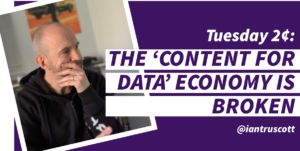This week I am inspired by a conversation on Twitter with Tim “Beg Data” Walters, an industry analyst, consultant and GDPR expert that got me thinking that this “content for data” economy is just a tiny bit f**ked, but it seems to be all we have.
Tim Walters is a Principal Strategist and the Privacy Lead at The Content Advisory, the go-to-guy on GDPR (in my opinion), I’ve known him for years and is a hugely intelligent fellow. Tim was railing on Twitter against a website that gave him a choice; ‘accept our cookie policy and read the article’ or leave (although Tim found a third way and read the article around the annoyingly huge cookie pop up), we had a little conversation and it got me thinking about this “data for content” economy we find ourselves in.
As someone that produces content, is a big fan of content marketing and has signed the checks on buying content to promote a brand, product or service, I tend lean toward the publisher in this kind of argument – is it the right of any website visitor to access content for free? Is that FAIR?
I don’t mean content that we as citizens need access to, I am not talking about accessibility and those rights, I mean commercial content that cost something for someone to produce.
I’ve previously talked about my policy as a CMO to offer valuable whitepaper content for free, without a registration gate and an exchange of an email address. When I mentioned this on LinkedIn, I got a comment that almost compared people that want free content with thieves.
My reasoning for ungated content is there are broadly two groups of people that download whitepapers from vendors; the first are people that are only interested in the asset and not the vendor (and I really don’t want their Gmail addresses) and the second group are people that are interested in both the asset and the vendor.
With the second group, you have to trust that if you don’t grab their email address on that occasion they will come back, register for a demo, meeting, engage with the relevant call to action when the time is right. In these data-driven days, trust is tough versus an email address (which was clear in the LinkedIn conversation I had on the topic), but why annoy them with a registration page before they are ready to engage?
Describing content as “free” also caused a problem for an analyst’s firm we were a client of. We’d paid a decent chunk of change to syndicate one of their reports on our website, but they balked at me calling it “free” when every single other one of their clients would put it behind a registration page.
The current model, gating content, tracking, and cookies are well understood, changing that is hard. Content costs money to produce, curate or commission. The justification for the spend is the number of views, clicks or new contacts that can be attributed to it.
This is a challenge; the mood music has changed, people are now able to go dark and marketers are blind to some of these simpler metrics. When I was at censhare after our strict implementation of cookie consent, we instantly ‘lost’ a big chunk of traffic.
For a B2B marketer at a reasonably sized business, this is a challenge of attribution and (in my opinion) a firm nudge in the right direction toward a focus on engagement rather than vanity metrics. I had a lovely conversation the other day that was worth more than anything Google analytics or my social media tracking could have told me – a CMO gave me feedback on an interview we’d done on Rockstar CMO. The lurkers are out there and they might be loving your content.
I also assume that it would have zero impact on Gartner’s report syndication business if marketers can’t justify the spend with hits, but I recently read that this dark audience is causing problems for small bloggers and content sites that rely on advertising revenue, measuring hits and page views.
This established “data for content” economy has got wonky, as internet users go dark, deny cookie consent, block ads (etc) there is more content and seemingly less data on offer to ‘pay’ for it.
Back to the conversation with Tim, there is no current alternative, our marketing technology infrastructure is all set up around this. Tim could either ‘pay’ for the article with a little bit of data and privacy by accepting the cookies (or, as Tim pointed out to me; 53 third-party trackers) or leave.
There is an interesting calculation to be made here, what if we could calculate the monetary value of dropping a cookie and give Tim the opportunity to pay that instead? That value would obviously vary hugely between websites and content, but this would surely be a tiny fraction of a cent for an article that Tim wanted to read (it had value to him).
I’m hoping to interview Tim for Rockstar CMO and dig into this for the next issue, but clearly, this data for content economy needs to change.
Fancy more of this?
Subscribe to my Rockstar CMO Newsletter

I’m a 3xCMO, now a marketing strategy advisor and podcast host at Rockstar CMO. Although, I’m not a rock star, but a marketing leader, strategist, content marketer, columnist, speaker, industry watcher, and creator of ART (Awareness, Revenue, and Trust) for the companies I work with. But most of all, I am an enthusiastic tea drinker.
You can find me on LinkedIn, Twitter, or now Threads! – or listen to my weekly podcast at Rockstarcmo.com
The half-baked thoughts shared on this blog may not reflect those of my employer or clients, and if the topic of this article is interesting or you just want to say hello please get in touch.
